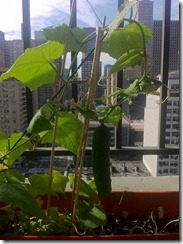One of the joys of planting vegetables is that you can show kids the magic of nature – how a little seed can germinate and then yield flowers and fruits is truly a magical experience for your kids. And, frankly, for us adults too.

Another benefit is that you can learn how things look like in nature! I’ve written before about how most of us have been so disconnected from the growing process that we no longer know what things look like in their original form, or where they come from. {You can take this quiz to see if you can answer where things come from.}
But another thing I’ve gained even more appreciation for lately is how smart plants are. It is truly outstanding. These living organisms are far more complex than I ever imagined.
Just a couple of examples I’ve learned about recently:
· Cucumbers self-regulate themselves to bear fruits at the pace they know they can handle, based on the conditions of the environment they are in: some may yield many cucumbers at the same time, if the soil, water, and space conditions permit, while others will pace themselves and allow some to mature faster than others.
· Radishes (and many other vegetables and roots do this also) can judge if the conditions will permit them to bear fruit (not sure I am using the right term here, but whether to form radishes); if the conditions are not right, they can opt to skip that step and instead focus on building themselves into plants that will yield seeds so that their energy and growth are not wasted on a failed journey.













